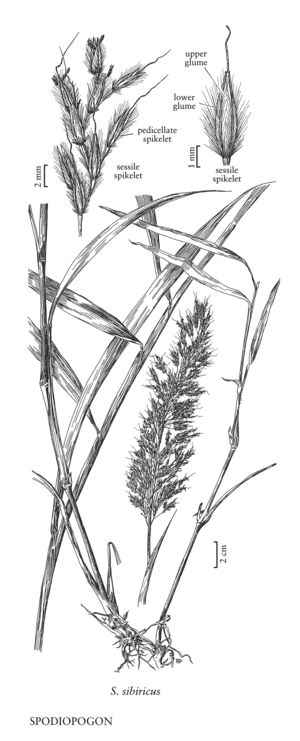Difference between revisions of "Spodiopogon sibiricus"
FNA>Volume Importer |
imported>Volume Importer |
||
| (2 intermediate revisions by the same user not shown) | |||
| Line 37: | Line 37: | ||
|publication year= | |publication year= | ||
|special status= | |special status= | ||
| − | |source xml=https:// | + | |source xml=https://bitbucket.org/aafc-mbb/fna-data-curation/src/200273ad09963decb8fc72550212de541d86569d/coarse_grained_fna_xml/V25/V25_1499.xml |
|subfamily=Poaceae subfam. Panicoideae | |subfamily=Poaceae subfam. Panicoideae | ||
|tribe=Poaceae tribe Andropogoneae | |tribe=Poaceae tribe Andropogoneae | ||
Latest revision as of 18:57, 11 May 2021
Plants rhizomatous. Culms 90-150 cm tall, 2-4 mm thick. Basal leaves bladeless or with reduced blades; cauline sheaths mostly glabrous, but pilose at the collar; ligules of cauline leaves 2-3 mm, ciliate on the erose margin; cauline blades to 35 cm long, 8-20 mm wide, pilose on both surfaces, margins ciliate near the base, cilia papillose-based. Panicles 12-20 cm long, 2-4 cm wide, shortly exserted; rachises glabrous, smooth; primary branches 2-6 cm; rames 2-3.5 cm. Spikelets 4.5-5.5 mm. Lower glumes pilose throughout, 5-9-veined; upper glumes of the sessile spikelets pilose on the margins, those of the pedicellate spikelets pilose throughout; callus hairs about 1/4 as long as the spikelets; awns 0.7-1.2 cm; anthers of the sessile spikelets about 2 mm, those of the pedicellate spikelets about 3 mm. 2n = 40, 42.
Discussion
Spodiopogon sibiricus is native to the grasslands of the montane regions that extend from central China to northeastern Siberia. It is grown as an ornamental in Canada and the contiguous United States.
Selected References
None.
